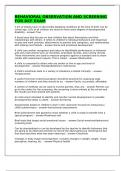BEHAVIORAL OBSERVATION AND SCREENING
FOR DCF EXAM
1-2% of infants have no discernible disabling conditions at the time of birth, but by
school age, 10% of all children are found to have some degree of developmental
disability - answer-True
A broad area that focuses on how children feel about themselves and their
relationships with others. It refers to children's individual behaviors and responses
to play and work activites, attachments to parents and caregivers, and relationships
with siblings and friends: - answer-Social and emotional development
A child care worker recognizes and notes an identifiable performance or behavior
and uses instruments such as checklists, anecdotal records, and running records.
These instruments are used to measure progress against a standard and to share
results with assessment experts. This is called: - answer-Observation
A child is compared to others who are similar to him in age and level of
development: - answer-Standardized/norm referenced
A child's emotional state in a variety of situations is tested clinically: - answer-
Temperament
A useful first-level screening program should be practical for assessing large
numbers of children and they should do so: - answer-Easily, accurately, affordably
A variety of methods can be used to involve parents, they are: - answer-Parents can
go to the center for the screening, the screening is done entirely at the school and
the results are then shared with parents
An instrument intended to identify and monitor normal development or possible
developmental delay is called: - answer-Screening
Assessments based on children's work in the classroom focused on measuring a
child's performance - answer-Instructional assessments
Brief achievement test geared to show whether a child is ready to benefit from a
special program: - answer-Readiness test
Brief tests that target social-emotional issues: - answer-Social-emotional/behavioral
screening tests
Can be standardized or can be developed by the teacher to identify behaviors that
are going to be observed and then to record the observations by checking the box
that best describes what was been observed: - answer-Checklists
Changes in body shape and proportion, includes changes in weight, height, visual
perception, hearing, etc. - answer-Physical health
, Components of the Brigance Screen are: - answer-It uses nine separate forms, it
measures speech-language and general knowledge, for the youngest age group it
measures social-emotional skills, it is designed to be administered in an educational
environment and can be administered by a para-professional, available in four
languages
Culture includes ideas about: - answer-ways to relate to one's elders, behavior
between boys and girls, roles of men and women, child rearing practices such as
discipline, toilet training, feeding, and bathing
Culture influences are important, it is made up of all the factors in an environment
that are accepted by the group as the norm. Culture includes: - answer-Attitudes,
values and beliefs, laws, ways of doing things
During this observation, the observer is concealed behind a screen or a 2-way
mirror and does not interact with a child: - answer-Non-participant observation
FDLRS/child find: - answer-The letters stand for Florida Diagnostic and Learning
Resources System, is coordinated with local school districts, locates children who
are potentially eligible for services under IDEA, provides information,training, and
supports districts and families to promote effective parent participation
Focuses on observations and provides initial information that can facilitate learning:
- answer-Developmental screening instruments
Key components of the Batelle Developmental Inventory are: - answer-It is a
developmental assessment for young children, its purpose is to screen, diagnose,
and evaluate early development, it measures personal-social, adaptive, motor,
communication and cognitive ability
Measures knowledge or skills a child has learned: - answer-Achievement tests
Observation and screening are successful when certain strategies are used. The
strategies are: - answer-A way to collaborate with parents, a system for planning
and scheduling activities, a plan for the initial follow through
Observation guidelines include: - answer-Know what to expect, observe a child over
a period of time, remember that difficulties in a single area are not necessarily
cause for alarm, record only what the child is doing and do NOT interpret
Once you have identified a child in your care that needs further assessment, the
actions you should take are: - answer-talk to the parent, decide where you will
direct the parent to turn for further assessment, know who in your local area can
answer questions about Early Intervention Providers
Parents write a narrative of their child's skills as they have observed them, and then
professional child care providers convert this information into measurable
information: - answer-Parent-completed assessments




